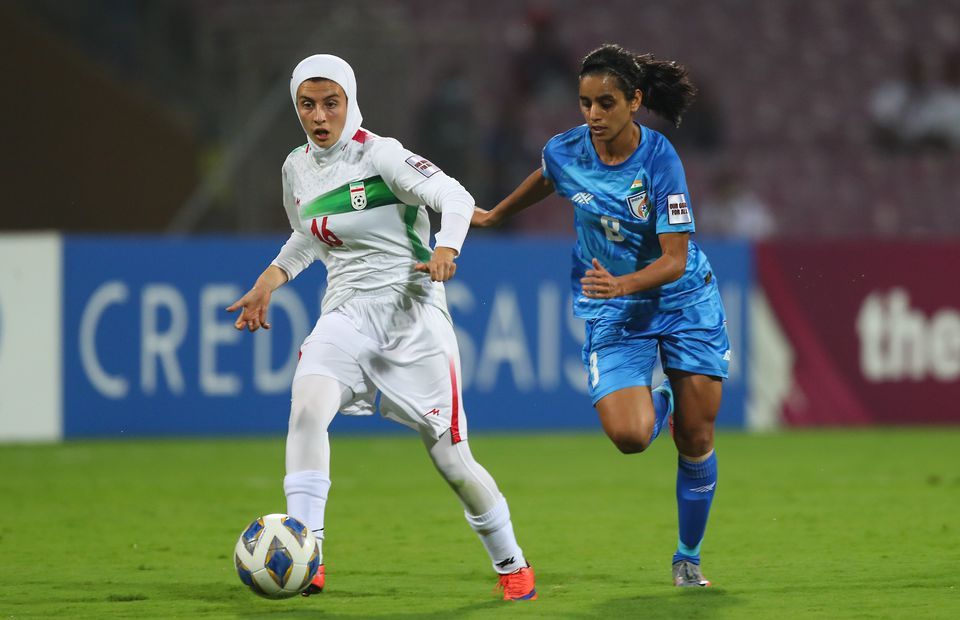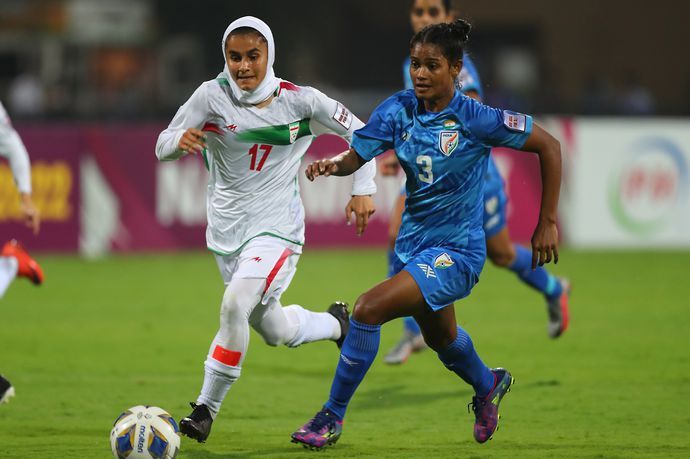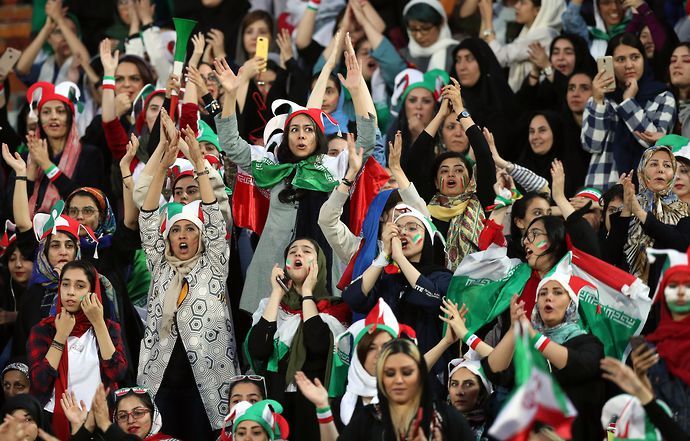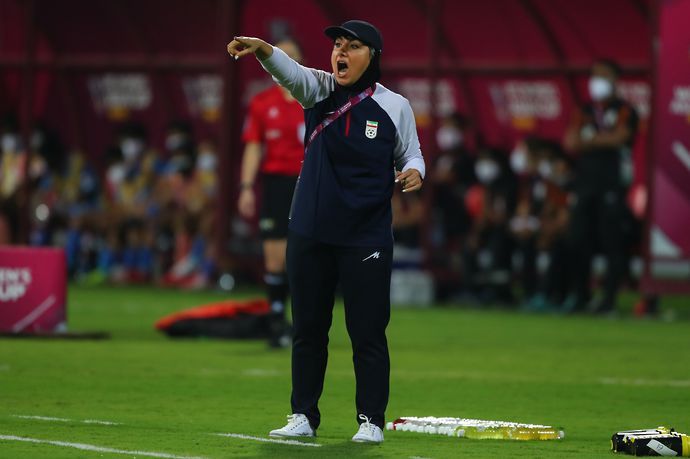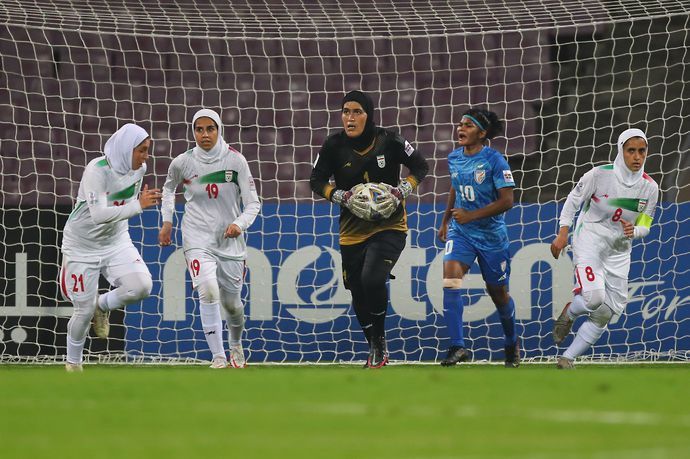Iran made their debut appearance at the Women’s Asian Cup on Thursday, holding hosts India to a 0-0 draw.The Blue Tigresses were the dominant side for the majority of the match, but Iran were resolute in defence.Goalkeeper Zohreh Koudaei was particularly impressive, helping her country to a well-earned point against a side 15 places higher in the world rankings.It was a poignant occasion for Iran’s female players, who have overcome countless obstacles to play the sport they love at the highest level.GiveMeSport Women explains just why Iran’s first appearance at the Women’s Asian Cup is so groundbreaking.
Ban on the hijab
Rewind to 2011, when Iran were preparing to play against Jordan in a qualifying match for the London 2012 Olympic Games.
The Iranian players were wearing headgear, an altered version of a hijab which did not cover their necks, as per FIFA regulations.
FIFA had banned the hijab back in 2007, citing health and safety reasons. This was despite the lack of empirical data suggesting the hijab could strangle a player or harm an opponent.
As a result of the ban, the Iranian women’s youth team were prevented from taking to the pitch at the Youth Olympic Games in Singapore in 2011. A compromise was reached, however, with the players allowed to wear headgear that did not cover the neck.
But just one year later, when Iran attempted to play against Jordan in the same headgear, they were forced to forfeit the match.
FIFA’s ban on the hijab ended in 2014, but by then, countless women had been ostracised from football due to a regulation which stemmed from ignorance.
It must have been bittersweet for the Iranian players to compete at the Women’s Asian Cup in hijabs, knowing they would not have been able to do so just eight years ago.
Ban on watching women’s football
Iran’s female players have not just faced barriers from external organisations. Back home, they have to navigate a society which does not see football as an appropriate environment for women.
This is best demonstrated by the ban on women entering Iranian football stadiums, which has been in place since the 1979 Islamic Revolution.
A horrific incident propelled the ban into the limelight in 2019. Twenty-nine-year old Sahar Khodayari was arrested that year after she disguised herself as a man and tried to sneak into a match at the Azadi Stadium.
She was released pending a court case, but learned that she could be tried by a revolutionary court and put in prison for six months. In despair, she set herself on fire, dying from her injuries a week later.
The story spread on social media, and FIFA sprung to action, forcing the hand of the Iranian Football Federation to allow women into the 2022 World Cup qualifier against Cambodia at the Azadi Stadium in October 2019.
It marked a break in the 40-year-ban on Iranian women entering football stadiums, but since then, there has been no sign of women being able to watch football matches on a permanent basis.
With this in mind, it is remarkable to see Iran’s female players overcome such attitudes and represent their country on the biggest stage.
Accused of being men
Once on the national team, Iran’s female footballers have still had to deal with discriminatory comments, sometimes regarding their gender.
The side has been accused twice of "fielding male players disguised as women" – once in 2015, and then again last year.
Koudaei was the target of the accusations last year – Jordan Football Association President Prince Ali Bin Al-Hussein revealed on Twitter he had submitted a "gender verification check" for Koudaei in September, and wished for an official investigation into the matter.
Iranian officials rejected the calls to have Koudaei’s sex investigated, with the goalkeeper describing the accusation as "bullying", revealing just how upsetting it is to have your gender questioned.
What’s next for Iran?
Iran have at least two more matches to play at the Women’s Asian Cup, coming up against China tomorrow and Chinese Taipei on Wednesday.
Depending on their results, the side could then progress into the knockout stages of the tournament.
Iran’s journey at the Women’s Asian Cup will be about more than how they play on the pitch, however.
Maryam Irandoost, daughter of retired Iranian footballer Nosrat Irandoost, is the head coach of the women’s national team.
She has revealed her aim is to change the perception of women’s football in Iran, and claimed support from the Iranian Football Federation would propel her side to the Women’s World Cup.
"Our team could be a role model for the Iranian women athletes," she said. "The condition for the country’s sportswomen has started to develop and is getting better day by day.
"I expect that, with proper planning, our women’s national teams will be organised in other age groups and a five-year plan for the growth and development of women’s football will be implemented.
"If the support from the Football Federation Islamic Republic of Iran and the people of IR Iran continues, I promise you that we will reach the FIFA Women’s World Cup in the next five years."




















